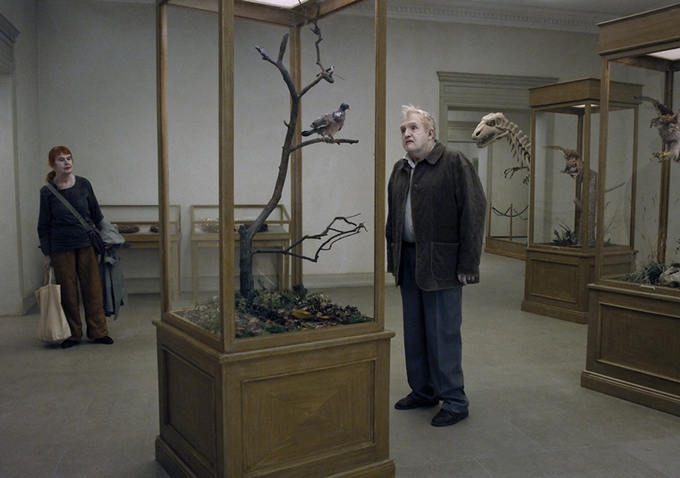 Roy Andersson takes his time. In 2000, he made international waves with "Songs From The Second Floor," but it took seven more years for his next effort, "You, The Living," to arrive. And now, another seven years has passed and he’s finally back and headed to Venice with "A Pigeon Sat On A Branch Reflecting On Existence."
Roy Andersson takes his time. In 2000, he made international waves with "Songs From The Second Floor," but it took seven more years for his next effort, "You, The Living," to arrive. And now, another seven years has passed and he’s finally back and headed to Venice with "A Pigeon Sat On A Branch Reflecting On Existence."
Holger Andersson and Nisse Vestblom are among the cast for the director’s latest, which the first images already reveal to be pretty visually striking. We’ll leave what he’s got coming to the official synopsis followed by his Note Of Intent: Like modern times’ Don Quixote and Sancho Panza, Sam and Jonathan, two travelling salesmen peddling novelty items, take us on a kaleidoscopic wandering through human destinies. A trip that shows us the beauty of single moments, the pettiness of others, the humour and tragedy that is in us, life’s grandeur as well as frailty of humanity.
———-
Bruegel the Elder: Among his other Renaissance masterpieces, the sixteenth century Flemish artist painted an exquisite landscape entitled “Hunters in the Snow”. From a snowy hilltop overlooking a small Flemish town, we see villagers skating on a frozen lake in a valley. In the foreground, three hunters and their dogs return from a successful hunt. Above them, perched on the naked branches of a tree, three birds curiously observe the endeavours and pursuits of the people below. Bruegel specialised in detailed landscapes populated by peasant and frequently adopted the sweeping perspective of a bird to tell a story of society and human existence. His oeuvre also contains fantastical allegories of man’s vices and follies, using flawless satire to express the tragic contains fantastical allegories of man’s vices and follies, using flawless satire to express the tragic contradictions of being. In his painting, “Hunters in the snow”, the birds appear to be speculating: “What are the humans doing down there? Why are they so busy?”
A Pigeon Sat on a Branch consists of a bird’s panoramic view of the human condition, in which the bird not only reflects on human existence but also worries deeply about it, as I do myself. The pigeon is astonished that humans do not see an approaching apocalypse, though it is in man’s ability to avoid destroying the future for themselves. A Pigeon Sat on a Branch shows the looming apocalypse and offers the possibility to believe in our capacity to avoid it.
Neue Sachlichkeit: With my last two movies I embarked upon what I call “abstraction”. I dared to leave realism and naturalism and entered the territory of abstract aesthetics. With A Pigeon Sat on a Branch, I will continue and perhaps go even deeper into abstraction, while making the images clearer and brighter. This ambition echoes the Neue Sachlichkeit/New Objectivity art movement that swept through Germany in the 1920s. The paintings were very clear, very concrete, very “Deutlich”. August Sander, a photographer from that time, also inspired me in his portrayal of German social classes. One photo (Pastry Chef 1928) features a chef stirring a casserole. He looks trapped, aggressive, and dangerous. Sander captured something essential there about social order in this single, unapologetic image. Some of my favourite Neue Sachlichkeit painters include Karl Hofer, Felix Nussbaum and Georg Scholz. Their combination of reality and fantasy resulted in abstracted condensed realism, a kind of “super-realism”, an ambition that I also have for A Pigeon Sat on a Branch, in which abstraction is to be condensed, purified, and simplified; scenes should emerge as cleansed as memories and dreams. Yes this is no easy task: “c’est difficile d’être facile” – it is difficult to be very simple, but I will try.
Homer: The nonlinear narrative found in Homer’s Odyssey, a work that, three thousand years later, remains uniquely profound and compelling, is an inspiration for the film. In Swedish and German, the word irrfärd/Irrfahrt, or wandering, suggests special, unexpected situations. In the Odyssey, Odysseus’s meandering Irrfahrt to Athens is characterized by an astonishing mix of logic, fantasy, and surprise. The journey in A Pigeon Sat on a Branch will involve myriad aspects of existence, reality, and time. The epic nature and content of the film references the thematic and contextual richness of The Odyssey. — Roy Andersson
The film’s running time is 101 minutes, and there’s no U.S. distributor yet. But hopefully this one gets on the fest circuit quickly and into arthouse theatres.








